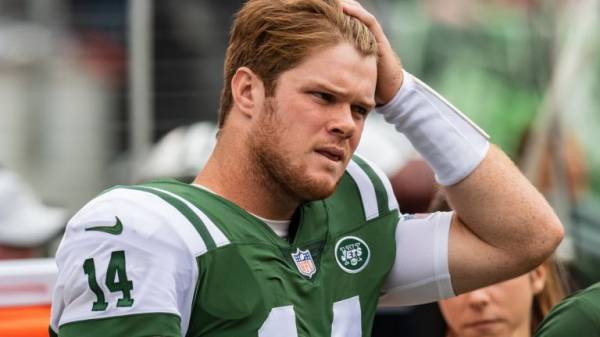NY Jets QB Sam Darnold Out With Mononucleosis: Handicapping Illnesses in the NFL Part I
The big news on Thursday morning’s NFL injury wire came out of New York: Jets quarterback Sam Darnold is ‘out indefinitely’ with mononucleosis.
|
*50% signup bonus up to $1000 |
There’s not much more specificity to the diagnosis that has been publicly released beyond a number of reports indicating that Darnold could be out ‘multiple weeks’. If there is a ‘silver lining’ to Darnold’s illness the timing could have been significantly worse. The Jets have a bye week in Week 4.
Reports indicate that the first indication for Darnold that something was amiss was a weight loss of around 5 pounds in a week. He received the diagnosis late Wednesday night—head coach Adam Gase, offensive coordinator Dowell Loggains and a Jets trainer showed up at his apartment to break the news to him personally. The second year quarterback didn’t practice on Wednesday and at the time the team indicated that it was due to ‘strep throat’. Unfortunately, the mononucleosis diagnosis is more serious at least in terms of how long Darnold could be out. At this point, the tentative projection is a return in Week 5 on the road against the Philadelphia Eagles.
The challenge for a professional athlete dealing with mono is twofold. First, there’s the immediate symptoms—sore throat, fever, fatigue, swollen lymph nodes and tonsils and headache. The Jets’ preliminary indication that Darnold was suffering from ‘strep throat’ isn’t surprising. Mononucleosis shares many of the symptoms and is often misdiagnosed as strep throat. Sometimes the first tip that a patient isn’t suffering from strep throat is when antibiotics are ineffective. Strep throat is a bacterial infection while mononucleosis is a viral infection. The incubation period is four to six weeks and this could be bad news for the Jets—although the team is taking precautions to keep Darnold away from the rest of the team it might be too late to avoid infecting other players.
The symptoms of mono listed above can last up to two weeks but that brings us to the second component that an athlete suffering from the illness has to deal with: fatigue along with a swollen spleen and enlarged lymph nodes can last up to a few weeks longer. The swollen spleen would likely keep Darnold on the sidelines until it subsides and the collateral fatigue/weight loss could further extend his absence.
ILLNESSES AMONG ATHLETES ARE TOUGH TO ISOLATE
Mononucleosis has long been nicknamed ‘the kissing disease’ and while it’s highly unlikely that Darnold has been kissing his teammates the real culprit is saliva. What might be an issue for the Jets’ locker room is that another common way of transmitting the illness is shared utensils—like water bottles—along with shared food, dishes and glasses. This could make the Jets’ efforts to keep Darnold away from the team ‘too little too late’.
Athletes in many sports are highly susceptible to ‘pocket outbreaks’ of illnesses. Staph infections have long been an issue for amateur wrestlers and to a lesser extent boxers and martial artists. There have also been outbreaks of infectious diseases in other team sports. The NBA suffered from a significant outbreak of the ‘stomach flu’ caused by a norovirus in 2019. The outbreak impacted as many as 13 teams with 21 players and three staff members getting ill. In 2014, the National Hockey League experienced a mumps outbreak that sidelined 14 players on five teams including Pittsburgh Penguins’ superstar Sidney Crosby.
There are some similarities between mumps and mononucleosis, at least in terms of how the illness is transmitted. Both are transmitted by saliva and frequently spread among players sharing water bottles. Both can also be spread through coughs and sneezes. Viral illnesses are often a significant problem for ‘enclosed populations’ like dorms, schools—or team locker rooms. There is some good news for the Jets—mononucleosis isn’t considered especially contagious relative to other illnesses. For example, it’s significantly less contagious than the common cold.
The immediate impact of Darnold’s diagnosis is that backup quarterback Trevor Siemian will start on Monday night against the Cleveland Browns and likely several games after that. Depth at quarterback is now a concern as the only other player at the position on the Jets’ depth chart is rookie Luke Falk out of Washington State. Darnold’s injury isn’t the only concern—the best strategy for dealing with the absence of a starting quarterback is to place a greater emphasis on an elite running back like Le'Veon Bell. Unfortunately, he's dealing with a shoulder injury and will miss Thursday’s practice to get an MRI. The Jets are already down a wide receiver--Quincy Enunwa was placed on injured reserve due to a neck injury and is done for the season.
The NFL pointspread at BetOnline.ag saw a rapid reaction to this news. The Browns had opened as a -2.5 road favorite and there had been little to no movement before the report of Darnold’s illness became public. In a little over an hour the line has shot up to Browns -6 and could go higher—particularly if Bell can’t go due to his shoulder injury.
In the second part of this examination of injuries in the NFL we’ll look at some more considerations for teams and players. We’ll also give some strategies for handicapping games involving a contagious illness of this type.















